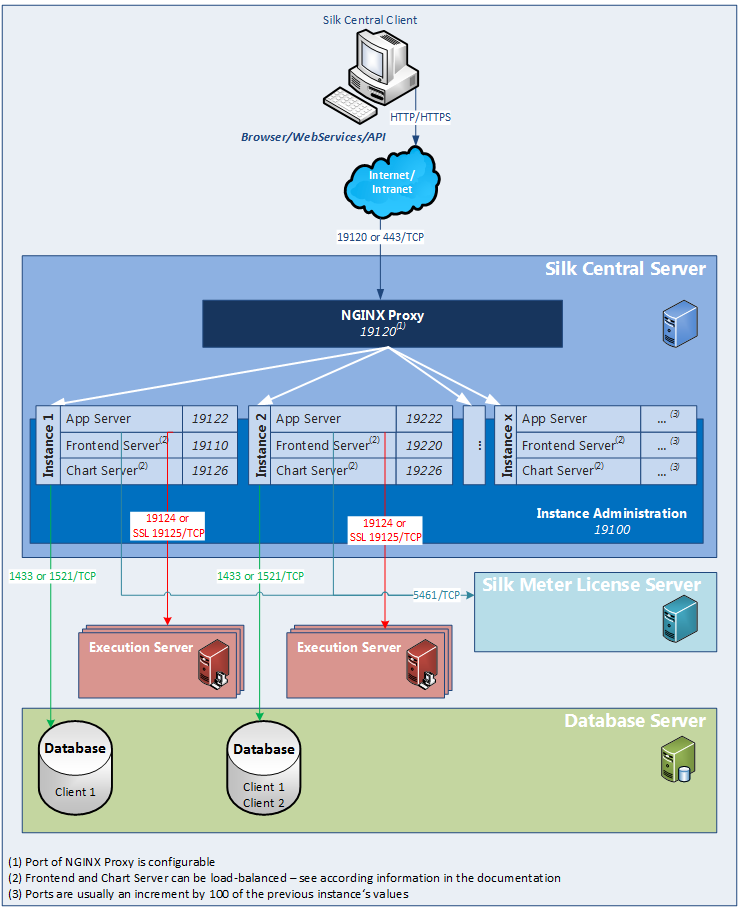Silk Central Architecture

Silk Central Server
The server on which the Silk Central Setup was executed.
Instance Administration
Instances and their Silk Central services are managed through a common user interface called Instance Administration, which you can access only on the server where Silk Central is installed, using the URL http://localhost:19100.
Instances
An instance is an independent set of Silk Central services (application server (AS), front-end server (FE) and chart server (CS)), with their own database and execution server (ES) connections. By default, Silk Central creates a single instance called silk for you. The default URL is http://<computer name>:19120/login (no port information required if Silk Central runs on IIS). Create additional instances if you need to physically separate test data and processes of your various clients for increased data security and reduced influence of independent user groups on each other (for example departments). With the help of clients you can further logically separate the data of one instance within one database.
Proxy
A proxy service is installed on the Silk Central server to control the access to the different instances. The services of each instance run on dedicated ports, but for security and increased flexibility reasons, the proxy routes the instance name to the actual URL in the form of http://<Silk Central server>:19120/<instance name>.
Application Server (AS)
The application server synchronizes tasks such as the distribution of schedules, control of execution servers, and management of database configuration. These tasks require a centralized agency to ensure the consistent, reliable behavior of the application. The application server also evaluates results, saves them to the database, and sends alerts based on success conditions. The application server uses port 19122 for the default instance. For every additional instance, this value is incremented by 100.
Front-End Server (FE)
The front-end server is responsible for the graphical user interface. This server is based on HTML and is accessible from any Web browser, such as Internet Explorer, Firefox and Chrome. A user sends an appropriate HTTP request to the front-end server and receives a login page for authentication. After successful login, the user can use the corresponding application based on the respective user rights. The front-end server can operate as a stand-alone HTTP server, or it can be attached to a Web server, such as IIS. The front-end server uses port 19110 for the default instance. The second instance uses port 19220 and for every additional instance, this value is incremented by 100. For secure connections with SSL, the server also uses port 443. The front-end server can be accessed through the URL http://<Silk Central server>:19120/<instance name> (no instance name required for default instance).
Chart Server (CS)
The chart server is used to generate charts that are viewed in reports. The system allows for the configuration of a pool of chart servers. A built-in load balancing mechanism uses the pool to distribute chart generation. The chart server is also used to generate reports and deliver them directly to the end-user for viewing within a browser. The chart server uses port 19126 for the default instance. For every additional instance, this value is incremented by 100.
Execution Server (ES)
The execution server executes automated tests that are scheduled by authorized users. Users are responsible for the proper configuration of execution servers and additional resources that are required for test executions. The system allows for the installation and configuration of multiple execution servers working independently of one another. The execution server uses port 19124 for the default instance. For secure connections with SSL, the server also uses port 19125.
Agent Computers:
- Silk Performer Agents
- Silk Performer agent computers host the virtual users that are run during load tests. As many agent computers as necessary can be added to a Silk Performer project so that the required quantity of virtual users can be run. Configuration of agents is done through Silk Performer. Refer to the Silk Performer documentation for details on configuring agents.
- Silk Test Classic Agents
- The same rules that apply to Silk Performer agents apply to Silk Test Classic agents, except Silk Test Classic agents host Silk Test Classic tests.
Database Server (DB)
System persistency is implemented using a RDBMS (Relational Database Management System). The database server uses ports 1433 (SQL Server) or 1521 (Oracle).
Silk Meter License Server
Silk Meter, the licensing software that accompanies Silk products, determines the Silk Central-application functionality that you may access. For more information on licensing, refer to the installation guide of the respective product. Silk Meter uses port 5461.
Clients
- User roles and permissions
- User groups and user accounts
- Projects
- Locations, execution servers and agent computers
- Products with components, versions and builds
- Global schedules
Projects
- Filters
- Attributes
- Requirement properties
- Step properties
- Notifications
- Integrated requirements and issue tracking tools
- Integrated source control system
- Data sources
- Status reasons
Important File Locations
- Instance administration and execution server log files: C:\ProgramData\SilkCentral\log
- Application-, front-end- and chart server log files: C:\ProgramData\SilkCentral\instance_<instance number>_<instance name>\log
- Location for hotfixes: C:\Program Files (x86)\Silk\Silk Central 20.0\hotfixes
- Configuration files: C:\Program Files (x86)\Silk\Silk Central 20.0\instance_<instance number>_<instance name>\Conf
- Plugins: C:\Program Files (x86)\Silk\Silk Central 20.0\instance_<instance number>_<instance name>\Plugins
- Office import mapping files: C:\ProgramData\SilkCentral\instance_<instance number>_<instance name>\OfficeImportMappingFiles